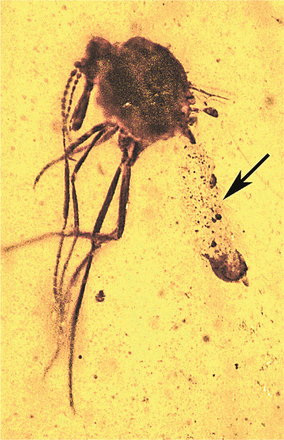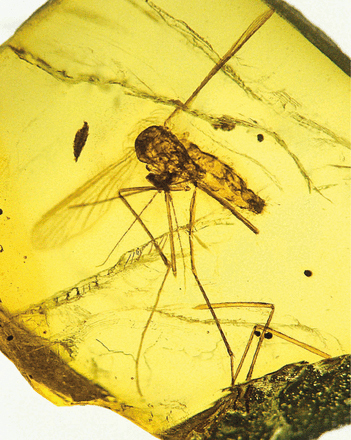Malaria Dates Back to the Cretaceous
The disease malaria which is a mosquito-borne infectious disease of humans and other animals caused by parasitic protozoans belonging to the Plasmodium type, killed an estimated 438,000 people in 2015. The World Health Organisation (WHO) reports that there were some 214 million cases last year and currently, this debilitating and often fatal disease accounts for 40% of all public health spending in Africa. Although, our understanding of the parasite and its life cycle has greatly improved over the last five decades or so, fundamental questions still remain. For example, when did the malaria vectors first evolve? Was malaria a disease of insects that transferred to vertebrates or did this disease originate in some prehistoric land vertebrate, a dinosaur perhaps?
Studying Malaria
Writing in the scientific journal the “American Entomologist”, researcher George Poinar Junior, a specialist in palaeo-entomology, sets out new research that seeks to establish for how long malaria has been plaguing our planet. He concludes that the origins of the disease can be traced back to the Cretaceous, a time when the Dinosauria dominated terrestrial ecosystems. The research suggests that dinosaurs would have probably been amongst the Plasmodium parasites first vertebrate hosts.
Fossil Evidence (Biting Midge) with Evidence of Malaria Parasite Infection Preserved in Amber

One hundred million-year-old Protoculicoides biting midge containing numerous oocysts (arrow) of the malarial parasite preserved in amber.
Picture credit: Oregon State University
Fossils Preserved in Amber
The picture above shows a 100-million-year-old biting midge, preserved in amber from Myanmar (Burma). The black arrow indicates numerous oocysts of the malarial parasite Paleohaemoproteus burmacis.
Zoologist George Poinar has specialised in studying ancient insects and other members of the Order Arthropoda. Much of his work has focused on the study of micro-organisms preserved in fossilised tree resin (amber). Everything Dinosaur has written a number of articles highlighting his research over the years, back in 2008 we wrote about a book co-authored by Professor Poinar that proposed the dinosaur extinction event was brought about, in part, due to disease transmission from biting ticks, mites and insects.
To read more about this: Biting Bugs Brought About the Demise of the Dinosaurs.
The Origins of Malaria
Understanding how malaria evolved and its long-term relationship with hosts can help scientists when it comes to searching for vaccines and other measures to eradicate the disease. The fossil record such as biting insects preserved in amber can help researchers to establish a better understanding.
Professor Poinar explained:
“Scientists have argued and disagreed for a long time about how malaria evolved and how old it is. I think the fossil evidence shows that modern malaria vectored by mosquitoes is at least 20 million years old, and earlier forms of the disease, carried by biting midges, are at least 100 million years old and probably much older.”
The modern strains of malaria are thought to have evolved much more recently, sometime between 15,000 years ago to perhaps as far back as 8 million years ago, before hominins evolved. The modern form of malaria is carried by Anopheles mosquitoes, but Professor Poinar suggests that the ancestral forms may have been spread by other types of biting insect.
A Tertiary Mosquito Preserved in Amber with a Malarial Parasite Infection
Picture credit: Oregon State University
The photograph above shows the preserved remains of the mid-Tertiary mosquito Culex malariager preserved in Dominican amber. Professor Poinar identified gametes inside the mosquitoes body and oocysts of the malaria parasite Plasmodium dominicana in various stages of development. This research, conducted in 2005, provided the first fossil record of Plasmodium malaria, demonstrating that the genus was established in the Americas at least fifteen million years ago.
Implications for this Research
If Poinar and his research team have hit the nail on the head, then ancestral malaria could have been influencing terrestrial vertebrate evolution from the Cretaceous onwards. Poinar proposes that other ancient insects such as sand flies, ticks as well as mosquitoes could have been malarial vectors. Of all these arthropods, the biting midges are the most ancient with a fossil record dating back to the Early Cretaceous, some 140 million years ago. This means that malaria could have had insect vectors this far back in geological time.
The professor is keen to point out that he is not claiming an ancient malaria pathogen caused the extinction of the dinosaurs, but he does suggest that diseases passed on via biting and sucking insects could have had an effect on populations that were already under considerable environmental stress.
The Professor added:
“There were catastrophic events known to have happened around that time, such as asteroid impacts and lava flows, but it’s still clear that dinosaurs declined and slowly became extinct over thousands of years, which suggests other issues must also have been at work. Insects, microbial pathogens and vertebrate diseases were just emerging around that same time, including malaria.”
Next time you see a mosquito, consider the evolutionary history of this winged creature and the evolutionary history of the deadly vector that some of its kind carries…







Leave A Comment